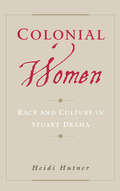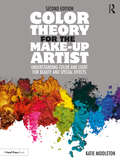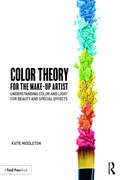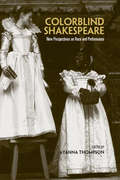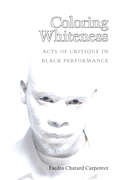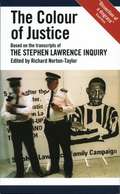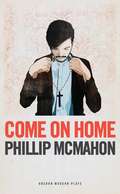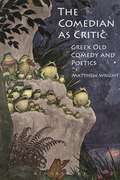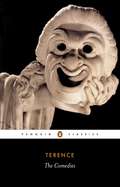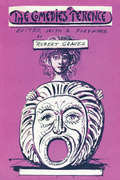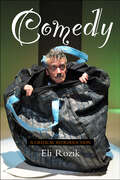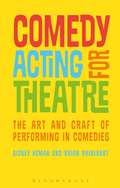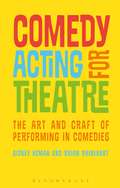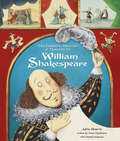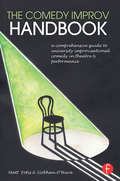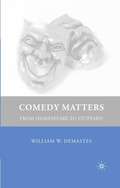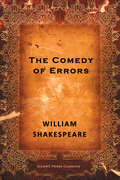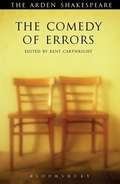- Table View
- List View
Colonial Women: Race and Culture in Stuart Drama
by Heidi HutnerColonial Women examines the women-as-land metaphor in English colonial dramatic literature of the seventeenth century, and looks closely at the myths of two historical native female figures--Pocahontas of Virginia and Malinche of Mexico--to demonstrate how these two stories are crucial to constructions of gender, race, and English nationhood in the drama and culture of the period. Heidi Hutner's interpretations of the figure of the native woman in the plays of Shakespeare, Fletcher, Davenant, Dryden, and Behn reveal how the English patriarchal culture of the seventeenth century defined itself through representations of native women and European women who have "gone native." These playwrights use the figure of the native woman as a symbolic means to stabilize the turbulent sociopolitical and religious conflicts in Restoration England under the inclusive ideology of expansion and profit. Colonial Women uncovers the significance of the repeated dramatic spectacle of the native women falling for her European seducer and exploiter, and demonstrates that this image of seduction is motivated by an anxiety-laden movement to reinforce patriarchal authority in seventeenth-century England.
Color Theory for the Make-up Artist: Understanding Color and Light for Beauty and Special Effects
by Katie MiddletonColor Theory for the Make-up Artist: Understanding Color and Light for Beauty and Special Effects (Second Edition) analyzes and explains traditional color theory for fine artists and applies it to make-up artistry. This beautifully illustrated guide begins with the basics of color theory – why we see color, how to categorize and identify color, and relationships between colors – and relates these concepts to beauty and special effects make-up. The book provides a wealth of information, including how to mix flesh tones by using only primary colors, how these colors in paints and make-up are sourced and created, the reason for variations in skin colors and undertones, and how to identify and match these using make-up while choosing flattering colors for the eyes, lips, and cheeks. Colors found inside the body are explained for special effects make-up, like why we bruise, bleed, or appear sick. Ideas and techniques are also described for painting prosthetics, in addition to using color as inspiration in make-up designs. The book also discusses how lighting affects color on film, television, theater, and photography sets, and how to properly light a workspace for successful applications. The second edition features: A brand-new chapter on color inspiration in make-up and design Additional and updated diagrams More real-life application photos and demonstrations, including new examples of tattoo covering and prosthetic painting using optical mixtures, airbrush, and stippling Expanded discussion on undertones, skin variations, color correction, pigments, colored gels, and more Filled with stunning photography and practical information, Color Theory for the Make-up Artist provides guidance and inspiration for both professionals and beginners who wish to train their eye further to understand and recognize distinctions in color.
Color Theory for the Makeup Artist: Understanding Color and Light for Beauty and Special Effects
by Katie MiddletonColor Theory for the Make-up Artist: Understanding Color and Light for Beauty and Special Effects analyzes and explains traditional color theory for fine artists and applies it to the make-up artist. This book is suitable for both professionals and beginners who wish to train their eye further to understand and recognize distinctions in color. It explains why we see color, how to categorize and identify color, relationships between colors, and it relates these concepts to beauty and special effects make-up. The book teaches the reader how to mix flesh tones by using only primary colors, and explains how these colors in paints and make-up are sourced and created. It also discusses the reason for variations in skin colors and undertones, and how to identify and match these using make-up, while choosing flattering colors for the eyes, lips, and cheeks. Colors found inside the body are explained for special effects make-up, like why we bruise, bleed, or appear sick. Ideas and techniques are also described for painting prosthetics, in addition to using color as inspiration in make-up designs. The book also discusses how lighting affects color on film, television, theater, and photography sets, and how to properly light a workspace for successful applications.
Color Theory for the Makeup Artist: Understanding Color and Light for Beauty and Special Effects
by Katie MiddletonColor Theory for the Make-up Artist: Understanding Color and Light for Beauty and Special Effects analyzes and explains traditional color theory for fine artists and applies it to the make-up artist. This book is suitable for both professionals and beginners who wish to train their eye further to understand and recognize distinctions in color. It explains why we see color, how to categorize and identify color, relationships between colors, and it relates these concepts to beauty and special effects make-up. The book teaches the reader how to mix flesh tones by using only primary colors, and explains how these colors in paints and make-up are sourced and created. It also discusses the reason for variations in skin colors and undertones, and how to identify and match these using make-up, while choosing flattering colors for the eyes, lips, and cheeks. Colors found inside the body are explained for special effects make-up, like why we bruise, bleed, or appear sick. Ideas and techniques are also described for painting prosthetics, in addition to using color as inspiration in make-up designs. The book also discusses how lighting affects color on film, television, theater, and photography sets, and how to properly light a workspace for successful applications.
Colorblind Shakespeare: New Perspectives on Race and Performance
by Ayanna ThompsonThe systematic practice of non-traditional or "colorblind" casting began with Joseph Papp's New York Shakespeare Festival in the 1950s. Although colorblind casting has been practiced for half a century now, it still inspires vehement controversy and debate.This collection of fourteen original essays explores both the production history of colorblind casting in cultural terms and the theoretical implications of this practice for reading Shakespeare in a contemporary context.
Colorblind Shakespeare: New Perspectives on Race and Performance
by Ayanna ThompsonThe systematic practice of non-traditional or "colorblind" casting began with Joseph Papp's New York Shakespeare Festival in the 1950s. Although colorblind casting has been practiced for half a century now, it still inspires vehement controversy and debate.This collection of fourteen original essays explores both the production history of colorblind casting in cultural terms and the theoretical implications of this practice for reading Shakespeare in a contemporary context.
Coloring Whiteness: Acts of Critique in Black Performance (Theater: Theory/Text/Performance)
by Faedra C CarpenterColoring Whiteness pays homage to the ways that African American artists and performers have interrogated tropes and mythologies of whiteness to reveal racial inequalities, focusing on comedy sketches, street theater, visual art, video, TV journalism, and voice-over work since 1964. By investigating enactments of whiteness—from the use of white makeup and suggestive masks, to literary motifs and cultural narratives regarding “white” characteristics and qualities—Faedra Chatard Carpenter explores how artists have challenged commonly held notions of racial identity. Through its layered study of expressive culture, her book considers how artistic and performance strategies are used to “color” whiteness and complicate blackness in our contemporary moment. Utilizing theories of performance and critical race studies, Coloring Whiteness is also propelled by Carpenter’s dramaturgical sensibilities. Her analysis of primary performance texts is informed not only by traditional print and visual materials, but also by her interviews with African American theater artists, visual artists, and cultural critics. The book is an invaluable contribution to the fields of theater and performance studies, African American studies, cultural studies, critical race studies, and American studies.
The Colour of Justice: Based On The Transcripts Of The Stephen Lawrence Inquiry (Modern Plays Series)
by Richard Norton-TaylorIn 1993, black teenager Stephen Lawrence was stabbed to death in a racist attack by a gang of white youths. The police investigation failed to provide sufficient evidence to convict.Based on the harrowing transcripts of the public inquiry, this is a dramatic reconstruction of the first hearings which reflected the national outcry at the police's mishandling of the case. First seen at the Tricycle Theatre, London, this remarkable production received instant acclaim and subsequently transferred to the West End.
Come On Home (Oberon Modern Plays)
by Phillip McMahonMichael hasn’t been back to Ireland in almost twenty years. Having been kicked out of the seminary and exiled from his family home, he found himself in London, by accident rather than design. But now, the death of his mother sees him back in the small town where he grew up. The place that chewed him up and spat him out. Reunited with his two brothers, their partners and the local clergy, there are questions that want answering and old scores that need laying to rest. Where do you find home, when your family and faith have abandoned you? An Irish funeral brings out the best and worst in people, and a long night of truths lies ahead.
The Comedian as Critic: Greek Old Comedy and Poetics
by Matthew WrightSome of the best evidence for the early development of literary criticism before Plato and Aristotle comes from Athenian Old Comedy. Playwrights such as Eupolis, Cratinus, Aristophanes and others wrote numerous comedies on literary themes, commented on their own poetry and that of their rivals, and played around with ideas and theories from the contemporary intellectual scene. How can we make use of the evidence of comedy? Why were the comic poets so preoccupied with questions of poetics? What criteria emerge from comedy for the evaluation of literature? What do the ancient comedians' jokes say about their own literary tastes and those of their audience? How do different types of readers in antiquity evaluate texts, and what are the similarities and differences between 'popular' and 'professional' literary criticism? Does Greek comedy have anything serious to say about the authors and texts it criticizes? How can the comedians be related to the later literary-critical tradition represented by Plato, Aristotle and subsequent writers? This book attempts to answer these questions by examining comedy in its social and intellectual context, and by using approaches from modern literary theory to cast light on the ancient material.
The Comedies: Translated Into English, Together With The Original Latin, From The Best Editions, ... Also, Critical And Explanatory Notes. To W
by Terence Betty RadiceThe Roman dramatist Terence (c. 186-159 BC) adapted many of his comedies from Greek sources, rendering them suitable for audiences of his own time by introducing subtler characterization and more complex plots. In his romantic play, The Girl from Andros, Terence portrays a love affair saved by a startling discovery. The Self-Tormentor focusses on a man's remorse after sending his son to war, and The Eunuch depicts a case of mistaken identity. Phormio is as rich in intrigue as a French farce, while The Mother-in-Law shows two families striving to save a marriage and The Brothers contrasts strict and lenient upbringings. With their tight plots and spare dialogue, Terence gave his plays a sense of humanity that became a model in the Renaissance and greatly influenced Molière.
The Comedies of Terence
by Robert GravesTerence achieved in his brief twenty-six years a standard of stylistic perfection and artistic restraint that ranked him, along with Plautus, as the greatest of the Roman comic playwrights. He was, at the very least, a gifted translator and adaptor, having used Greek New Comedies as the basis for all six of his extant plays. How far his own contribution exceeded that of simple translation is difficult to say, but we know that the Latin, undeniably his, was so faultlessly styled that his work served as a textbook for scholars and grammarians for hundreds of years.Terence had a considerable impact on the Revival of Letters; his comedies were studied and were frequently adapted into new works by such men as Steele, Chapman, and, most famously, Moliire. Indeed, had there been no Terence, it is doubtful that the Comedy of Manners could have arisen when it did, and all comic writing for the stage, from Moilire through the Restoration drama to the present day, would be diminished for lack of him. Appropriately, the language of this translation is from the Restoration. Graves has based his version on the one made in 1689 by Laurence Echard; he has corrected inaccuracies, eliminated defects and obscurities, but retained the period tone.Including in this book are the major comedies: The Fair Andrian, The Mother-In-Law, The Self-Tormentor, The Eunuch, The Tricks of Phormio and The Brothers. A close reading of Terence is a fine corrective to any idea that may still be current, about the glory that was Greece and grandeur that was Rome during the Hellenistic period. It is an assurance that in some respects at least, this age is not depraved at all.
The Comedies of Terence
by Robert GravesTerence achieved in his brief twenty-six years a standard of stylistic perfection and artistic restraint that ranked him, along with Plautus, as the greatest of the Roman comic playwrights. He was, at the very least, a gifted translator and adaptor, having used Greek New Comedies as the basis for all six of his extant plays. How far his own contribution exceeded that of simple translation is difficult to say, but we know that the Latin, undeniably his, was so faultlessly styled that his work served as a textbook for scholars and grammarians for hundreds of years.Terence had a considerable impact on the Revival of Letters; his comedies were studied and were frequently adapted into new works by such men as Steele, Chapman, and, most famously, Moliire. Indeed, had there been no Terence, it is doubtful that the Comedy of Manners could have arisen when it did, and all comic writing for the stage, from Moilire through the Restoration drama to the present day, would be diminished for lack of him. Appropriately, the language of this translation is from the Restoration. Graves has based his version on the one made in 1689 by Laurence Echard; he has corrected inaccuracies, eliminated defects and obscurities, but retained the period tone.Including in this book are the major comedies: The Fair Andrian, The Mother-In-Law, The Self-Tormentor, The Eunuch, The Tricks of Phormio and The Brothers. A close reading of Terence is a fine corrective to any idea that may still be current, about the glory that was Greece and grandeur that was Rome during the Hellenistic period. It is an assurance that in some respects at least, this age is not depraved at all.
Comedy: A Critical Introduction
by Eli RozikHerewith an original approach to the study of comedy. While assimilating theoretical insights from Aristotle to the present day, it contests, inter alia, the theory of comedy's ritual origin; challenges the age-old and continuing attempts to determine the structure of action that characterises comedy; and suggests instead that structures of action are shared by all genres, and that it is the specific mood that accounts for their differences. Mood is a prism through which a playwright wishes the spectator to perceive a fictional world. Comedy is characterised by its light-hearted mood, which generates a specific kind of laughter. If mood determines the genre of a fictional world, in contrast to current theory, comedy, satiric drama and grotesque drama are different genres promoting different moods and aiming at different effects. Each genre should thus be read and experienced according to its inherent rules and not in terms of a theory that lumps these genres together. The book discusses the pivotal role of commedia dell'arte in both reflecting comedy's classical tradition and influencing subsequent developments, especially in comedy's style of acting; it explores the relations between comedy and carnival and between comedy and joke-telling; probes the view that comedy is characterised by a unique vision; and examines comedy in different media -- such as cinema, comics, puppet theatre, radio drama and TV drama. Eli Rozik questions the traditional semiotic view that all meaning is in the text, and suggests that, in generating comedic meaning, the spectator's contribution/reaction is no less vital than that of the text itself. Major contributions to a general theory of comedy, and to a sound methodology for the analysis of comedies, are presented, and ample reference to comedies and/or pertinent analyses of such comedies, written over the course of 2,500 years of theatre recorded history, is provided to enable readers to grasp ideas in their original terminology and logic. Each presentation is accompanied by critical comments which attempt both to introduce the problems involved and suggest possible solutions.
Comedy: A Critical Introduction
by Eli RozikHerewith an original approach to the study of comedy. While assimilating theoretical insights from Aristotle to the present day, it contests, inter alia, the theory of comedy's ritual origin; challenges the age-old and continuing attempts to determine the structure of action that characterises comedy; and suggests instead that structures of action are shared by all genres, and that it is the specific mood that accounts for their differences. Mood is a prism through which a playwright wishes the spectator to perceive a fictional world. Comedy is characterised by its light-hearted mood, which generates a specific kind of laughter. If mood determines the genre of a fictional world, in contrast to current theory, comedy, satiric drama and grotesque drama are different genres promoting different moods and aiming at different effects. Each genre should thus be read and experienced according to its inherent rules and not in terms of a theory that lumps these genres together. The book discusses the pivotal role of commedia dell'arte in both reflecting comedy's classical tradition and influencing subsequent developments, especially in comedy's style of acting; it explores the relations between comedy and carnival and between comedy and joke-telling; probes the view that comedy is characterised by a unique vision; and examines comedy in different media -- such as cinema, comics, puppet theatre, radio drama and TV drama. Eli Rozik questions the traditional semiotic view that all meaning is in the text, and suggests that, in generating comedic meaning, the spectator's contribution/reaction is no less vital than that of the text itself. Major contributions to a general theory of comedy, and to a sound methodology for the analysis of comedies, are presented, and ample reference to comedies and/or pertinent analyses of such comedies, written over the course of 2,500 years of theatre recorded history, is provided to enable readers to grasp ideas in their original terminology and logic. Each presentation is accompanied by critical comments which attempt both to introduce the problems involved and suggest possible solutions.
Comedy Acting for Theatre: The Art and Craft of Performing in Comedies (Performance Books)
by Sidney Homan Brian RhinehartAnalysing why we laugh and what we laugh at, and describing how performers can elicit this response from their audience, this book enables actors to create memorable – and hilarious – performances.Rooted in performance and performance criticism, Sidney Homan and Brian Rhinehart provide a detailed explanation of how comedy works, along with advice on how to communicate comedy from the point of view of both the performer and the audience. Combining theory and performance, the authors analyse a variety of plays, both modern and classic. Playwrights featured include Harold Pinter, Tom Stoppard, Christopher Durang, and Michael Frayn. Acting in Shakespeare's comedies is also covered in depth.
Comedy Acting for Theatre: The Art and Craft of Performing in Comedies (Performance Books)
by Sidney Homan Brian RhinehartAnalysing why we laugh and what we laugh at, and describing how performers can elicit this response from their audience, this book enables actors to create memorable – and hilarious – performances.Rooted in performance and performance criticism, Sidney Homan and Brian Rhinehart provide a detailed explanation of how comedy works, along with advice on how to communicate comedy from the point of view of both the performer and the audience. Combining theory and performance, the authors analyse a variety of plays, both modern and classic. Playwrights featured include Harold Pinter, Tom Stoppard, Christopher Durang, and Michael Frayn. Acting in Shakespeare's comedies is also covered in depth.
Comedy and Crisis: Pieter Langendijk, the Dutch, and the Speculative Bubbles of 1720 (Eighteenth-Century Worlds #9)
Comedy and Crisis contains the first ever scholarly English translation of Pieter Langendijk’s Quincampoix, or the Wind Traders [Quincampoix of de Windhandelaars], and Harlequin Stock-Jobber [Arlequin Actionist]. The first play is a full-length satirical comedy, and the second is a short, comic harlequinade; both were written in Dutch in response to the speculative financial crisis or bubble of 1720 and were performed in Amsterdam in the fall of 1720, as the bubble in the Netherlands was bursting. Comedy and Crisis also contains our translation of the extensive apparatus prepared by C.H.P. Meijer (Introduction and notes) for his 1892 edition of these plays. The current editors have updated the footnotes and added six new critical essays by contemporary literary and historical scholars that contextualize the two plays historically and culturally. The book includes an extensive bibliography and index. The materials assembled in Comedy and Crisis are a rich resource for cultural, historical, and literary students of the history of finance and of eighteenth-century studies.
The Comedy, History and Tragedy of William Shakespeare
by Anna ClaybourneAward-winning, beautifully illustrated introduction to William Shakespeare for children; celebrating his life, his most famous plays and the time in which he lived. Vividly brings to life Shakespeare's school days in Stratford-Upon-Avon, what it was like to live in Elizabethan London and the world of Tudor theatre in Shakespeare's Globe theatre. Fun, charming summaries of some of Shakespeare's best-loved plays help make the works of our greatest playwright accessible for children and introduces them to his most famous characters. Much more than a biography, this is an entertaining, informative look at our most celebrated playwright. The perfect guide to help children be part of the Shakespeare 400 celebrations in 2016 and to open up the magical world of the bard for them.Won the Judges Highly Commended Award at the 2015 SLA Information Book Awards and has been shortlisted for the English 4-11 Picture Book Awards. Can be used to support the teaching of Shakespeare in the classroom and ahead of taking children to the theatre to see one of his plays for the first time. Suitable for children aged 7+ . Fun activity sheets and other resources to accompany the book can be found at http://www.shakespeareforschool.uk/the-book.html
The Comedy Improv Handbook: A Comprehensive Guide to University Improvisational Comedy in Theatre and Performance
by Matt Fotis Siobhan O'HaraThe Comedy Improv Handbook: A Comprehensive Guide to University Improvisational Comedy in Theatre and Performance is a one-stop resource for both improv teachers and students, covering improv history, theory, maxims, exercises, games, and structures. You will learn the necessary skills and techniques needed to become a successful improviser, developing a basic understanding of the history of improvisation and its major influences, structures, and theories. This book also addresses issues associated with being a college improviser – like auditions, rehearsals, performances, and the dynamics of improv groups.
The Comedy Improv Handbook: A Comprehensive Guide to University Improvisational Comedy in Theatre and Performance
by Matt Fotis Siobhan O'HaraThe Comedy Improv Handbook: A Comprehensive Guide to University Improvisational Comedy in Theatre and Performance is a one-stop resource for both improv teachers and students, covering improv history, theory, maxims, exercises, games, and structures. You will learn the necessary skills and techniques needed to become a successful improviser, developing a basic understanding of the history of improvisation and its major influences, structures, and theories. This book also addresses issues associated with being a college improviser – like auditions, rehearsals, performances, and the dynamics of improv groups.
Comedy Matters: From Shakespeare to Stoppard
by W. DemastesComedy Matters traces the long tradition of the expansive comic embrace of cultural difference and diversity that manages to survive even in some of mankind s darkest moments. Demastes argues that comedy has a hard-nosed, pragmatic dimension that can be mobilized against belligerent cultural forces. Drawing from the works of Shakespeare, Stoppard, and a number of other comic masters, Comedy Matters demonstrates how comedy continues to work against cultural regimentation by striving to re-calibrate our decision-making processes and challenging the stultifying rigidity of human economy in the broadest sense of the term.
The Comedy of Errors
by William ShakespeareIdentical twins separated at birth provides the foundation for humour in one of Shakespeare's earlier plays. The young twin sons of Egeon, alongside another set of young twin boys, purchased as slaves, are lost to one another during a tempest at sea. As each searches for the other, the stage is set for a romp that revolves around mistaken identity, physical mishaps, and the comedy of errors referenced in the title.
The Comedy of Errors: Third Series (The Arden Shakespeare Third Series)
by William ShakespeareShakespeare's dextrous comedy of two twin masters and two twin servants continually mistaken for one another is both farce and more than farce. The Comedy of Errors examines the interplay between personal and commercial relationships, and the breakdown of social order that follows the disruption of identity. As well as detailed on-page commentary notes, this new edition has a long, illustrated introduction exploring the play's performance and crtitical history, as well as its place in the comic tradition from Classical to modern times.
The Comedy of Errors
by William ShakespeareBook Description The shortest and probably earliest of Shakespeare's comedies, The Comedy of Errors is the story of identical twin brothers who are raised apart-and then mistaken for each other.
